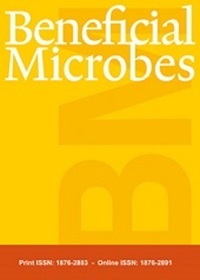APOE4基因与阿尔茨海默病肠道菌群的相关性
IF 3
4区 医学
Q2 MICROBIOLOGY
引用次数: 1
摘要
肠道微生物群(GM)生态失调与阿尔茨海默病(AD)的关系越来越密切。然而,散发性阿尔茨海默病最常见的遗传风险因子APOE4与阿尔茨海默病中的GM之间的关系尚不清楚。在这项研究中,我们对来自中国和美国的参与者进行了比较分析,包括携带和不携带APOE4基因以及患有或不患有AD(67例AD病例,67例对照病例)。结果表明,AD_ APOE4、Control_ APOE4、AD_non- APOE4和Control_non- APOE4组间的基因多样性差异无统计学意义(分别为419.031±143.631 vs 391.091±126.081、351.086±169.174和386.089±177.200)。。有趣的是,AD_ APOE4组的个体具有不同的细菌组成和细菌生物标志物。Kruskal-Wallis秩和检验结果显示,AD_ APOE4患者中多种细菌的丰度与对照组存在差异,其中未分类的大肠杆菌-志贺氏菌的丰度降低(4组分别为1.763±6.73、4.429±11.13、8.245±16.55和5.69±13.91);, unclassified_g_Clostridium_sensu_stricto_1(分别为0.1519±0.348、2.502±5.913、0.5146±0.9487、1.063±3.428);4组患者的gut_metagenome_g_Faecalibacterium分别升高(2.885±4.47,2.174±3.957,0.5765±1.784,1.582±2.92)。未分类_g_bacteroides(4组分别为3.875±3.738、2.47±2.748、2.046±3.674、3.206±3.446);。在KEGG通路水平2分析中,我们发现AD_ APOE4和ad_非APOE4携带者组之间预测功能的相对丰度存在三个显著差异:神经退行性疾病(0.0007±0.0005 vs 0.0009±0.0004;P & lt;0.01),代谢(0.0240±0.0003 vs 0.0250±0.0003;P & lt;0.05),其他次生代谢物的生物合成(0.0094±0.0002 vs 0.0090±0.0002;P & lt;0.05)。受试者工作特征曲线进一步表明,ad_apoe4携带者和ad_非APOE4携带者的曲线下面积(AUC)为0.74。本文章由计算机程序翻译,如有差异,请以英文原文为准。
Correlation between APOE4 gene and gut microbiota in Alzheimer’s disease
Abstract Gut microbiota (GM) dysbiosis has been increasingly associated with Alzheimer’s disease (AD). However, the association between APOE4 , the most common genetic risk factor for sporadic AD, and GM in AD remains unclear. In this study, we conducted a comparative analysis of the GM of participants from China and the USA, with and without APOE4 genes and with or without AD (67 AD cases, 67 control cases). Our results revealed that the GM alpha diversity was not different between groups (AD_ APOE4 , Control_ APOE4 , AD_non- APOE4 , and Control_non- APOE4 ) (419.031 ± 143.631 vs 391.091 ± 126.081, 351.086 ± 169.174 and 386.089 ± 177.200, respectively. ). Interestingly, individuals in the AD_ APOE4 group had different bacterial compositions and bacterial biomarkers. The Kruskal-Wallis rank sum test indicated that the abundances of many bacterial species in the AD_ APOE4 patients differed from those in control individuals, including decreases in unclassified_g__Escherichia-Shigella (1.763 ± 6.73, 4.429 ± 11.13, 8.245 ± 16.55, and 5.69 ± 13.91 in four groups, respectively; ), and unclassified_g_Clostridium_sensu_stricto_1 (0.1519 ± 0.348, 2.502 ± 5.913, 0.5146 ± 0.9487, 1.063 ± 3.428 in four groups, respectively; ), and increases in gut_metagenome_g_Faecalibacterium (2.885 ± 4.47, 2.174 ± 3.957, 0.5765 ± 1.784, 1.582 ± 2.92 in four groups, respectively. ) and unclassified_g_Bacteroides (3.875 ± 3.738, 2.47 ± 2.748, 2.046 ± 3.674, 3.206 ± 3.446 in four groups, respectively; ). In the KEGG pathway level 2 analysis, we identified three significant differences in relative abundances of predicted functions between AD_ APOE4 and AD_non- APOE4 _carrier groups: neurodegenerative diseases (0.0007 ± 0.0005 vs 0.0009 ± 0.0004; P < 0.01), metabolism (0.0240 ± 0.0003 vs 0.0250 ± 0.0003; P < 0.05), and biosynthesis of other secondary metabolites (0.0094 ± 0.0002 vs 0.0090 ± 0.0002; P < 0.05). Receiver operating characteristic curves further demonstrated an area under the curve (AUC) of 0.74 for the discrimination of AD_ APOE4 _carrier and AD_non- APOE4 _carrier individuals.
求助全文
通过发布文献求助,成功后即可免费获取论文全文。
去求助
来源期刊

Beneficial microbes
MICROBIOLOGY-NUTRITION & DIETETICS
CiteScore
7.90
自引率
1.90%
发文量
53
审稿时长
>12 weeks
期刊介绍:
Beneficial Microbes is a peer-reviewed scientific journal with a specific area of focus: the promotion of the science of microbes beneficial to the health and wellbeing of man and animal. The journal contains original research papers and critical reviews in all areas dealing with beneficial microbes in both the small and large intestine, together with opinions, a calendar of forthcoming beneficial microbes-related events and book reviews. The journal takes a multidisciplinary approach and focuses on a broad spectrum of issues, including safety aspects of pro- & prebiotics, regulatory aspects, mechanisms of action, health benefits for the host, optimal production processes, screening methods, (meta)genomics, proteomics and metabolomics, host and bacterial physiology, application, and role in health and disease in man and animal. Beneficial Microbes is intended to serve the needs of researchers and professionals from the scientific community and industry, as well as those of policy makers and regulators.
The journal will have five major sections:
* Food, nutrition and health
* Animal nutrition
* Processing and application
* Regulatory & safety aspects
* Medical & health applications
In these sections, topics dealt with by Beneficial Microbes include:
* Worldwide safety and regulatory issues
* Human and animal nutrition and health effects
* Latest discoveries in mechanistic studies and screening methods to unravel mode of action
* Host physiology related to allergy, inflammation, obesity, etc.
* Trends in application of (meta)genomics, proteomics and metabolomics
* New developments in how processing optimizes pro- & prebiotics for application
* Bacterial physiology related to health benefits
 求助内容:
求助内容: 应助结果提醒方式:
应助结果提醒方式:


